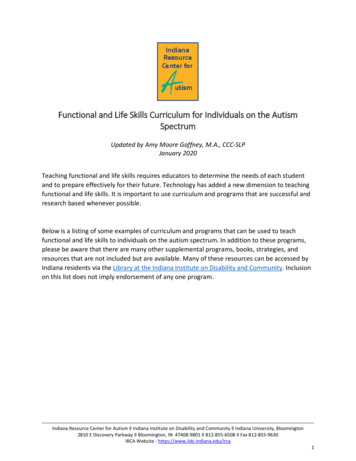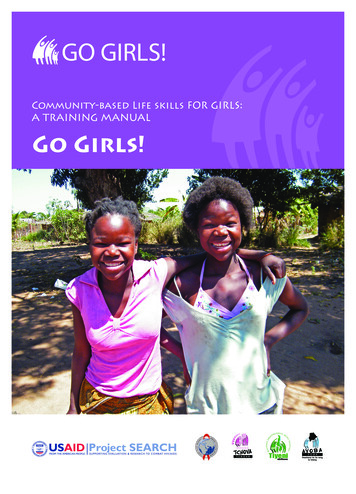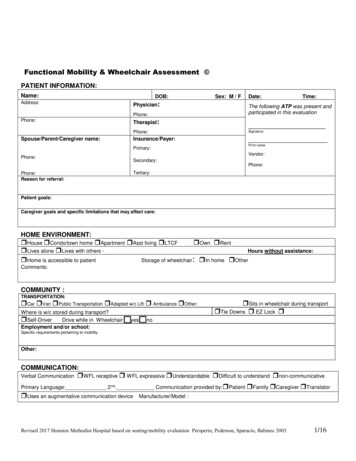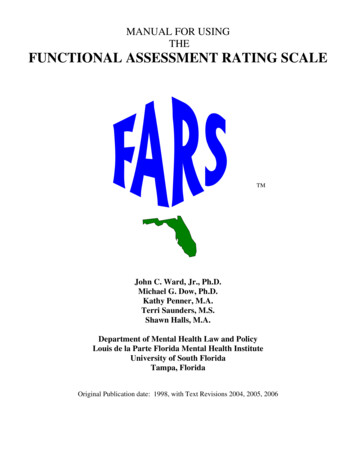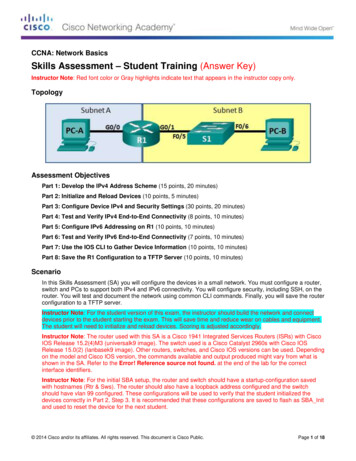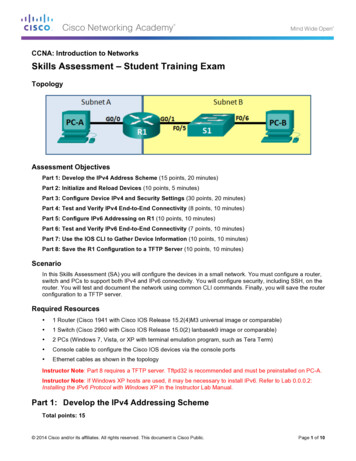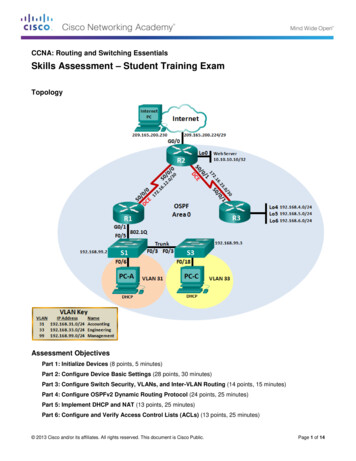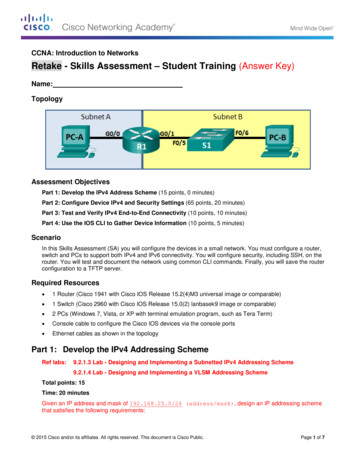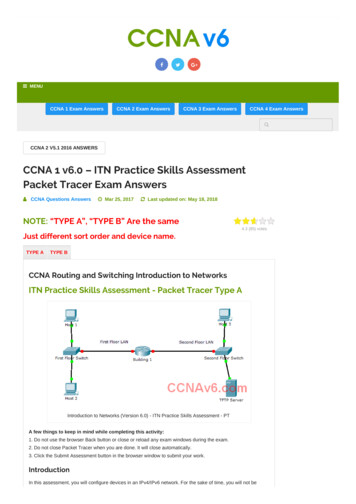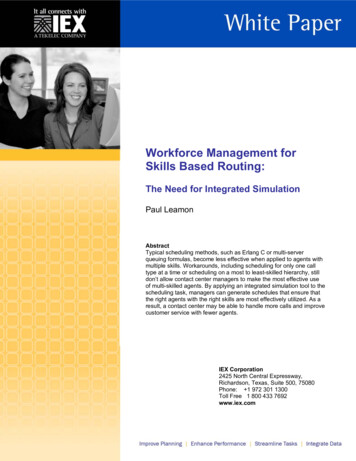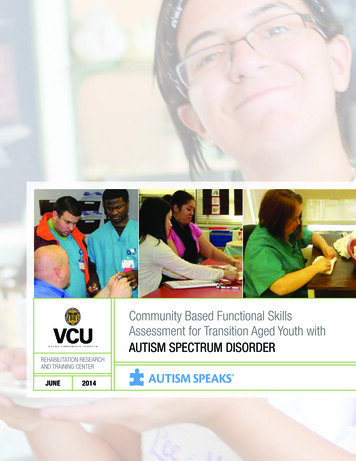
Transcription
Community Based Functional SkillsAssessment for Transition Aged Youth withAutism Spectrum DisorderRehabilitation Researchand Training CenterJUNE2014
TABLE OF CONTENTSAUTISM SPEAKS7PAGEIntroduction. 1What is an Assessment?. 1How does it work?. 31.2.3.4.5.6.Assessment and Observation Planning Tool. 3Scheduling the Observation. 3Conducting the Observations. 3Conducting the Interview. 3Scoring the Assessment. 3Calculating the Score. 4Assessment and Observation Planning Tool. 5A. Client Details. 5B. People Interviewed. 5C. Interest and Preferences. 5D. Education. 6E. Medical Information. 6F. Benefit Status. 7Assessment Planning. 7Functional Skills Assessment -- OBSERVATION. 9Home Observation. 9Self-Determination/Advocacy. 9Health and Safety. 9Peer Relationships, Socialization, Social Communication. 10Leisure/Recreation. 11Home Living. 12Leisure/Recreation Observation. 15Self-Determination/Advocacy. 15Health and Safety. 15Peer Relationships, Socialization, Social Communication. 16Community Participation and Personal Finance. 18Leisure/Recreation. 19Transportation. 20
PAGEWork Observation.23Career Path and Employment.23Self-Determination/Advocacy.24Health and Safety.24Peer Relationships, Socialization, Social Communication.25Community Participation and Personal nctional Skills Assessment -- INTERVIEW.31Career Path and Employment.31Self-Determination/Advocacy.33Health and Safety.34Peer Relationships, Socialization, Social Communication.37Community Participation and Personal me Living.44Score Sheet.47
about the assessmentThis assessment tool was developed for Autism Speaks through a contract with VirginiaCommonwealth University’s Rehabilitation Research and Training Center. While a reviewof the literature did not produce an assessment tool that matched the needs of youth withAutism Spectrum Disorder (ASD), it did assist in illuminating the critical areas of functionallife skills. The project selected these functional skills areas based upon the instrumentsthat were reviewed and purported to contribute to the successful functioning of an individualinto adulthood.This tool was designed to assess an individual’s knowledge, skill and social communicationabilities. A number of individuals worked on this product to include Carol Schall, ValerieBrooke, Paul Wehman, Sue Palko, Alissa Brooke, Whitney Ham, Staci Carr, Peter Gerhardt,Adam Dreyfus, and Holly Tate. Additional thanks go to Katherine Inge for her review of thisdocument and to the number of individuals with ASD, their families and educators that trustedus with their time and talent as we worked collaboratively to shape this final product.About the Virginia Commonwealth UniversityRehabilitation Research and Training CenterEstablished in 1983, the Virginia Commonwealth University Rehabilitation Research andTraining Center (VCU-RRTC) serves as a center of national and international excellence inthe field of disability and employment services. The VCU-RRTC played a major leadershiprole in designing and implementing supported employment, a program now found in everystate across the country and over 30 countries worldwide. For over 30 years this center hasstayed in the forefront of education and employment services to individuals with disabilitieswith a concentration on services and supports to individuals with autism. The Center’s professional team, led by Dr. Paul Wehman, are renowned experts and committed to developingand advancing evidence based practices to support and advance individuals with disabilities.About Autism SpeaksAutism Speaks is the world’s leading autism science and advocacy organization. It is dedicated to funding research into the causes, prevention, treatments and a cure for autism;increasing awareness of autism spectrum disorders; and advocating for the needs ofindividuals with autism and their families. Autism Speaks was founded in February 2005 bySuzanne and Bob Wright, the grandparents of a child with autism. Mr. Wright is the formervice chairman of General Electric and chief executive officer of NBC and NBC Universal.Since its inception, Autism Speaks has committed more than 500 million dollars to itsmission, the majority in science and medical research. Each year Walk Now for AutismSpeaks events are held in more than 100 cities across North America. On the global front,Autism Speaks has established partnerships in more than 40 countries on five continents tofoster international research, services and awareness. To learn more about Autism Speaks,please visit AutismSpeaks.org.The contents were developed for Autism Speaks, “Functional Community Based Assessment”. Virginia Commonwealth University, School ofEducation and Department of Physical Medicine and Rehabilitation is an equal opportunity/affirmative action institution providing access to educationand employment without regard to age, race, color, national origin, gender, religion, sexual orientation, veteran’s status, political affiliation, ordisability. If special accommodations are needed, please contact Vicki Brooke at (804) 828-1851 VOICE or (804) 828-2494 TTY.
Community Based Functional Skills Assessment for TransitionAged Youth with Autism Spectrum DisorderRehabilitation Researchand Training CenterIntroductionThe challenges associated with the transition from school services to adulthood for individualswith disabilities are well documented. The process can often be a very overwhelming andchallenging one as families worry about the individual’s future: What kind of job will he have?Where will she end up living? Will he ever be independent? What will make her the happiest?Every individual with autism is different and as a result, there is no “one size fits all” plan for thepath to adulthood. A transition plan involving job training and skill development that is fitting forone person with autism may be ineffective for another. The most important factor in creating aplan is to focus on the individual. His or her strengths, needs, challenges and preferences willplay a critical role in ensuring a successful transition process.A key ingredient in creating a transition plan for an individual with autism is a transitionassessment that leads to comprehensive skill development in the final years of school. When astudent turns 14, the focus of his or her Individualized Education Program will likely shift awayfrom math and English to vocational training and community living skill development. This shift infocus necessitates a shift in assessment priorities. That is, instead of measuring what a studentcannot do, it is time to measure the student’s interests, preferences, strengths and work habitsand based on these factors, describe the supports and modifications that will be necessary forthe student to be successful in the future.What is an Assessment?The Community Based Functional Skills Assessment for Transition Aged Youth with Autismwas designed to help parents and professionals assess the current skill levels and abilities ofindividuals with autism beginning at age 12 and continuing into adulthood in order to develop acomprehensive plan. The purpose is to assist teams in identifying areas of instructional priorityfor the individual. While employment support needs of individuals are addressed throughcommunity-based internships and work experiences through school, this is the first tool to assessneeds in the area of community-based living from transportation to financial management to peerrelationships and more.The tool is designed for transition aged youth and is divided into three levels based upon theage of the individual being assessed. This is important because the skills identified will be agereferenced based on the individual’s peer group. The levels and definitions are as follows: Level 1 Life Aware: his group includes youth ages 12 to 16 who are betweenTmiddle school and sophomore year of high school. Level 2 Life Explorer: This group includes youth ages 17 to 22 who are in theirjunior or senior year of high school. Level 3 Life Seeker: This group includes individuals who are post high school andseeking postsecondary education and/or employment.1
After conducting a careful analysis to illuminate the critical areas of functional life skills,eight skill sets were identified and collapsed into the categories below:Career path and employment The items in this section assess the individual’sprogress towards developing job seeking skills and/or employment. This section covers suchjob topics as: demonstrates work habits by performing chores at home, explores opportunitiesby job shadowing, volunteer or using a mentor, indicates personal strengths, completes aresume and secures a competitive job.Self-determination/advocacy The items in this section review the skills that youthwith autism need to develop and the challenges that they will face living and working in thecommunity. Specifically, this section will cover a variety of skills that would indicate that theindividual is able to demonstrate some control of his or her life. This section covers skills suchas: goal setting, IEP participation, choice making, self-regulation, problem solving, requestingsupport and disability awareness. Health and safety Assessment items in this area cover a vast range of independentliving skills. These items include basic to advanced hygiene, fire safety, home safety,medication management, self-management and general sexuality information. Peer relationships, socialization and social communication Thisarea is the most detailed section of the assessment. For individuals with ASD, the interactionbetween two or more people, requiring the processing of both verbal and nonverbal cues,can be an arduous task. It is important to assess skills across multiple environments becausemany people with ASD understand language so concretely that they may miss the subtlemeanings of social information, as well as experience issues with generalization. This sectioncovers skills across home, work and leisure/recreation environments while assessing if theindividual can initiate a skill, as well as respond to a social communication situation.Community participation and personal finance This area focuses ona variety of independent living skills assessed across areas that include making decisionsthat affect an individual’s life, taking care of personal affairs and pursuing areas of personalinterest. Community participation items assess the extent to which a youth with ASD uses andinteracts with local restaurants, stores, parks, libraries, places of worship, community events,government activities and volunteering.Transportation Transportation can be confusing and frightening to many individualswith ASD, so this assessment item is of critical importance. Generally, these skills will have tobe taught along with socially appropriate behavior requirements within each of these settings. Leisure/recreation Developing and engaging in leisure/recreation activities isimportant for all community members. As with other community members, when individualswith ASD join in a community event, they engage in a stress relief activity and have theopportunity to make new friends. Skills that are present in this section include: identifiespreferred activities, uses technology for enjoyment and schedules opportunities for exerciseand/or participation in community activities. Home living skills Whether an individual with ASD is living at home, in a group homeor independently or with a roommate, home living skills are essential. This section will reviewboth basic and advanced skill sets that include eating and preparing meals, cleaning tasks,doing laundry and home repair.2
How does it work?The assessment uses both a criterion-based observation and interview-based process to measure knowledge,skills and behaviors. Interviews will include obvious areas such as personal care and hygiene, but will also beused across all skill assessment categories. Observations will be purposeful and will occur in multiple settingsincluding recreation/leisure, employment, education and home.1. Assessment and Observation Planning ToolIt is essential that the assessment and observation planning tool in this booklet is completed prior to doingany observations. It is recommended that this section be completed either over the phone or through email.2. Scheduling the Observations When administering this assessment, it is helpful to complete all of the observations first. When schedulingthe observations with the individual with ASD, the family and the education or work site, it is important that theperson completing the observations is familiar with the skills he or she will be observing. It is also important toschedule them during an activity that enables the observer to collect accurate information about the individual.For example, when conducting the leisure/recreation observation, try to ensure that it is an activity that allowsfor social interaction with the individual’s peer group and involves the person using transportation into thecommunity. Before conducting the observation at the person’s place of employment, be sure to communicatewith the individual’s job coach and/or supervisor about the observation and ask if there is a good place for youto conduct the observation so that you are out of the way of other employees.3. Conducting the ObservationsIt is essential when conducting the observation section that enough time is allotted to observe all of thecategories. Items that focus on social interaction such as peer relationships should be scored only aftersufficient time has passed in order to obtain an accurate rating. It is recommended that the observations lastat least an hour and a half. When completing the observation section, please be careful not to disrupt ongoingroutines and activities. Be sure to complete all three observations before scheduling the interview process.4. Conducting the Interview Interview times will need to be arranged with the individual, primary caregivers and a member of either theschool or the employment site (job coach or supervisor). The interview session should be completed in arelaxed environment that is familiar and comfortable for the individual, ideally his or her home environment.There are 78 interview questions grouped into eight categories. The number of questions asked will depend onwhich of the three levels the individual is in. For example, under the category of self-determination, individualsin Level 1 will complete questions 11-17, while individuals in Levels 2 and 3 will complete questions 11-18.5. Scoring the AssessmentWhen scoring items on the assessment, it is critical to stay mindful of both of the scoring scales. The first scalerates the level of independence with which the individual is able to perform the skills. The second scale ratesthe individual on the number of environments where he or she performs the skills. When scoring an item,always start with number 1 and continue up the scale until you find the score that corresponds to theindividual’s level of performance.3
Ratings are assigned in the following manner:A rating of 1 is given when the individual does not perform the skill at all.A rating of 2 is given when the individual requires physical prompting to perform the skill.An example of this would be hand over hand or full physical prompting.A rating of 3 is given when the individual performs the skill but requires extensive prompting.Extensive prompting is defined as the use of three or more different types of prompts, modeling,pictorial, verbal or written. rating of 4 is given when the individual is able to perform the skill but requires limitedAprompting. Limited prompting is defined as the use of one or two of the following types ofprompts: gestural, verbal, pictorial and/or written.A rating of 5 is given when the individual is able to perform the skill with no prompts required.He or she may still need to have supervision but is performing the skill independently.When scoring the Environmental Scale, start with a rating of 1 and continue upward untilyou obtain the correct score for the individual.A rating of 1 is given when the individual does not perform the skill, therefore is not completingit in any environment.A rating of 2 is given when the individual is performing the skill in one or two familiarenvironments. rating of 3 is given when the individual is performing the skill in three or more environments.AThe environments should include unfamiliar environments.6. Calculating the Score After you have attained a final score for each of the individual items for each domain, you will total thescores across all items within a domain and place
Community pArtiCipAtion And perSonAl finAnCe This area focuses on a variety of independent living skills assessed across areas that include making decisions that affect an individual’s life, taking care of personal affairs and pursuing areas of personal interest. Community participation i
